Park life
A look at the beautiful green spaces we have here in Chesterfield and their stories.
Since Victorian times, public parks have provided a welcome green space. They are places in which people are able to relax, play and explore and can bring communities together. This exhibition explores the stories of Chesterfield’s parks.
A Chesterfield Museum Service exhibition. With special thanks to Friends of Eastwood Park, Friends of Holmebrook Valley Park, Friends of the Inkerman, Friends of Queen’s Park and Friends of Stand Road.
A park for the town
Queen’s Park was Chesterfield’s first public park, built to commemorate Queen Victoria’s Golden Jubilee. It provided a much needed green, open space at a time when many of the town’s inhabitants lived in poor, cramped conditions.
Since its official opening in 1893, the park has been a focus for leisure activities and events in the town. Cricket, football, cycling, a children’s playground and rowing on the lake have been features of the park since its early days as well as events such as flower shows, athletics and musical entertainment.
In 2001, the park was granted Grade II listed status and underwent a large restoration and improvement project which was completed in 2004.
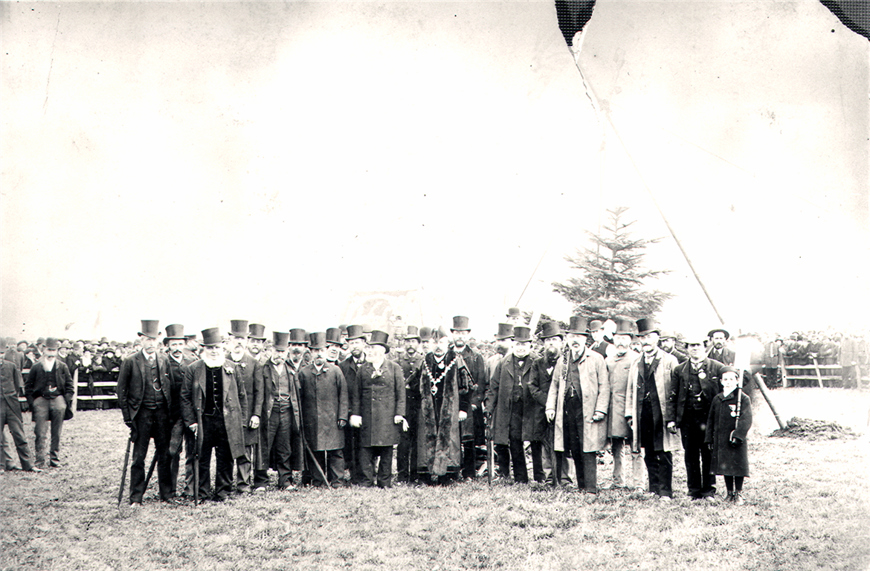
The dedication of Queen’s Park in 1887.
The purchase of the land was raised by public subscription and fund raising but it was not until 1893 that the layout of the park was complete. Alderman T P Wood (pictured centre) was the driving force behind Queen’s Park.
The original wooden band kiosk was built at the request of Alderman TP Wood. When he was made a Freeman of the Borough in 1887, he asked for the kiosk in place of the traditional silver casket. It was replaced by a metal band stand in 1922.
The miniature railway was added to the park in the 1976. The railway used some of the old track-bed of the Midland Railway branch line which ran along the northern edge of the park. In 1986, the railway was moved to run around the lake.
After restoration, the park was officially re-opened in 2005 by HRH The Earl of Wessex. The £4 million project was funded by the Heritage Lottery and the Borough Council and included the restoration of the conservatory, new play areas, improved drainage and the upgrade of its buildings.
Cricket has been a feature of the park since it opened. The first match was played 5th May 1894, between Chesterfield ‘A’ and Clay Cross Park with a win for the home side.
June 1898 saw the first county game between Derbyshire and Surrey (the visitors winning by an innings). The park has also seen international matches from touring teams, including Australia and South Africa. It is home to Chesterfield Cricket Club.
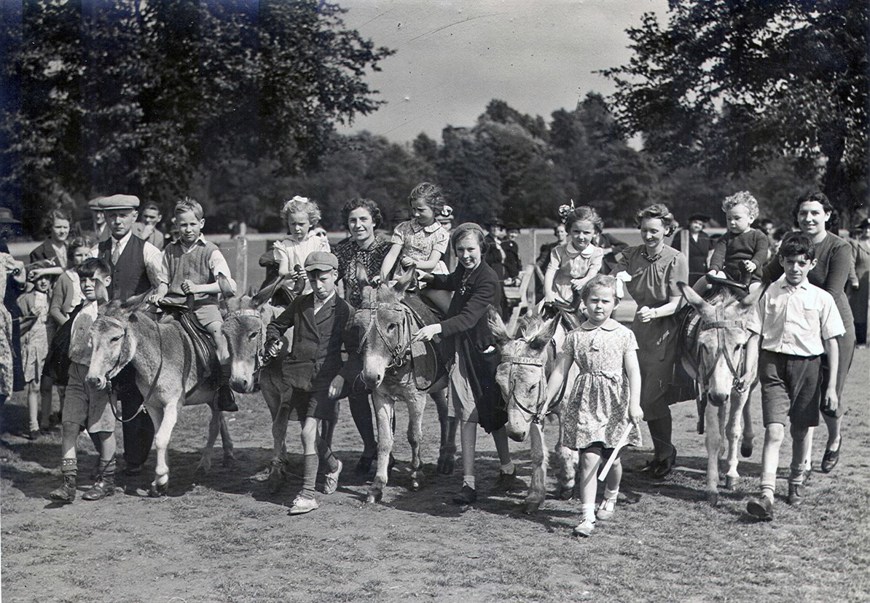
During the Second World War, the Council launched a ‘Holidays at Home’ scheme. This was a programme of summer entertainment in the Borough at a time when people couldn’t travel easily. Donkey rides were enjoyed in Queen’s Park. Other wartime changes to the park included the removal of the metal railways around the cricket pitch and growing food in the conservatory.
The Friends of Queen’s Park was established in 2002 to preserve, promote and protect the park’s heritage. They worked closely with the council during the 2005 restoration project and continue to assist with events, promotion and fundraising.
Alderman Eastwood’s gift
Hasland House and the adjoining land were offered as a gift by Alderman George Eastwood to the local community in 1912 to be used as a public park. The council accepted the gift with ‘hearty thanks’ and voted to name it ‘Eastwood Park’ in his honour rather than the suggested ‘Hasland Park’. It was officially opened in July 1913 by Alderman Eastwood’s niece.
In 2006, the condition of the Park had noticeably deteriorated. Local people established the Friends of Hasland Park and worked with the Borough Council to restore and regenerate the Park. In 2012, with funding from the Heritage Lottery and the Big Lottery Fund as well as the Borough Council, regeneration work began. This included the restoration of the fountain and the village hall, a community garden, improvements to footpaths and new play areas. The re-opening of the Park in June 2013 was a fitting centenary celebration.
The official opening of the Park in 1913 saw a day of celebration. School children enjoyed a tea while the grounds of the park were taken up with entertainments such as Punch and Judy, music and conjuring.
The village hall was the gift of Bernard Clayton Lucas, a descendant of the original owners of Hasland Hall. The village hall was built alongside the Hall and was completed in 1914. The hall was used for ARP training in World War II and continues to be used for a range of activities including dancing, dog training and parties.

The fountain in Eastwood Park was donated by Alderman Charles Paxton Markham. It was transferred from his grounds at Ringwood Hall and installed in time for the opening in 1913. In the 1980s, the fountain was relocated to New Square in Chesterfield town centre. It was returned to Eastwood Park in 2000.

Alderman George Edward Eastwood was Mayor of Chesterfield from 1905-1907. As well as running the successful Eastwood Wagon Works, inherited from his father, Edward Eastwood, he was a JP and on the board of many local organisations. The park was a gift in memory of his father. Alderman Eastwood was made a Freeman of the Borough on the day of the park opening.
Facilities have been added to the park over the years. Tennis courts were built in the 1920s as was a bowling green (another was added in 1934) while a cricket square, football pitch and play area were included in the 1950s. Shown here is the 2013 play area.
Part of the community
Inkerman (Wasp Nest)
The Inkerman on Ashgate Road was originally a Victorian industrial site. Coal mining, brick works (Inkerman Brick Company and Wasp Nest Brick Company) and Ashgate Pottery all used the site and surrounding land.
The extraction of clay for the brickworks resulted in a large clay pit. After Wasp Nest’s closure in the 1940s, it became Inkerman Pool; home to Chesterfield Swimming Club. In the 1970s, the pool was filled in and the site became a park.
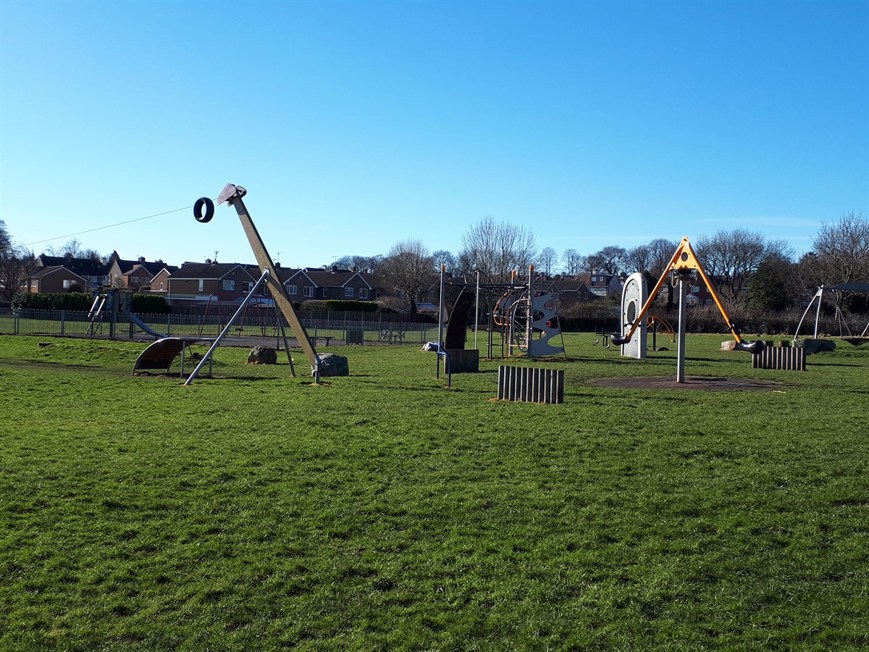
Friends of the Inkerman was formed in 2007 and worked with the Borough Council to improve the park, securing funding for a new playground, path and benches as well as planting apple trees. They also organise an annual litter pick.
Stand Road
The site of Stand Road Park, Newbold Moor, was originally adjacent to Chesterfield racecourse. The land, originally owned by the Duke of Devonshire and Mr Johnson Pearson, was acquired by the Council in 1922/3 who intended it for housing and recreation. In 1924 the last horse race was held.
Stand Road boasts football pitches, a multi-use games area, playground and skate park but it’s also a popular location for events such as fairgrounds, the Fake Festival and the Bonfire Night fireworks.
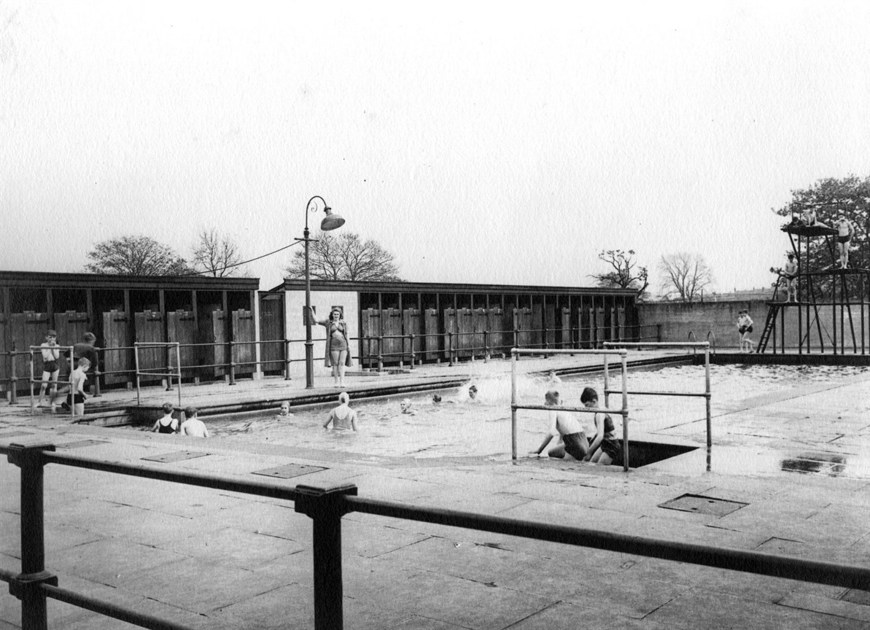
The open air baths at Stand Road opened in 1936. In 1983 detailed plans were drawn up for a leisure centre to be built on Stand Road Park including an ice rink. However later that year, the project was dropped and additional indoor sports facilities were added to Queen’s Park Swimming Baths. Stand Road Baths closed shortly afterwards.

The programme for the last Chesterfield Races in 1924.
The acquisition of the land by the Council for housing and the park was hotly debated with many wishing to keep the racecourse. The argument included the fact that the racecourse was only used for two days a year while the park was provided for 365 days.
The finishing straight of the racecourse ran along Stand Road and it is possible that the park was the location of the horses’ paddock for the horses.
Friends of Stand Road were formed in 2002 at a time when the park was neglected and under used. After community consultation, a plan was developed for the future and funding secured for projects to improve the park. These have included a new entrance, skate park and play equipment.
The annual fireworks display is just one of the popular events held at the park. Over 20,000 people attended in 2017.
Brampton green spaces
Hidden in the housing estates of Walton and Brampton, is Walton Dam and Somersall Park.
Walton Dam was built in the 18th century and provided controlled water power for Walton Manor Corn Mill. Enlarged to its current size in the early 19th century, the site and the mill were bought by Robinson’s in 1899. Not only was the Dam a useful source of water for their cotton wool production at Walton Works, but also provided an area for their employees to take part in sporting and leisure activities from swimming to cricket.
Somersall Park was given to the Borough Council in 1930 by Robinson and Sons and the Derbyshire Playing Fields Association. Its playing fields were laid out for cricket and football and brass band concerts were held in the summer months.
Walton Dam has been home to Chesterfield Barbarians Cricket Club since the 1940s. The club has adult and junior teams competing throughout the summer months.

The area of Walton Dam and Somersall Park is a popular walk and part of the Hipper Valley Trail cycle route. The water is home to a range of wildlife and is a significant wintering ground for Mandarin ducks.
The River Hipper flows through Somersall Park and then past Walton Dam. The water from the river fills the dam.
Somersall Park has been used for a range of events from a Sunday School treat held in 1933 to a Christmas lantern parade in 2017.
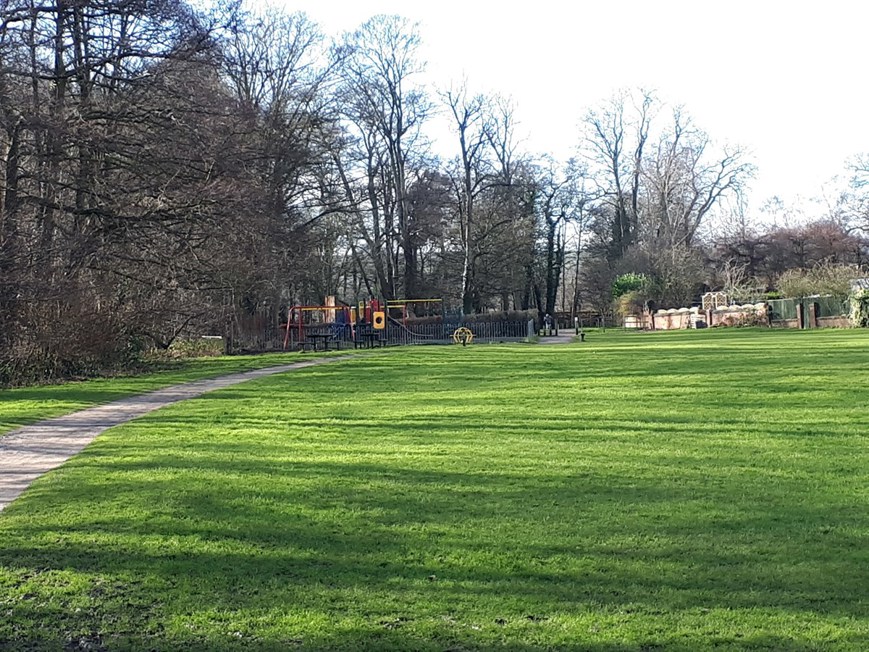
A 2018 view of the playground at Somersall Park. Friends of Somersall Park were formed in 2014 to improve and update the Park including fundraising for a new children’s play area.
Green Spaces out of Industrial Spaces
Two of Chesterfield’s largest parks, Holmebrook and Poolsbrook, were once industrial sites. They have been transformed into areas for leisure and havens for wildlife as country parks.
Holmebrook Valley Park
As well as being used for farming, the site of Holmebrook Valley Park, to the east of Chesterfield town centre,had been exploited for coal, ironstone and clay since the 1600s until the around the mid-20th century. In 1980s, Chesterfield Borough Council and Fitzwise Ltd – joint owners of the site – embarked on a project to transform the area into a country park.

Covering a site of 141 acres, this was an ambitious project which included the creation of a 6.5 acre lake at the heart of the site. Sports fields, meadows and bridleways were also included in the project. It officially opened in April 1995 and now provides a habitat to a range of wildlife from water voles to moorhens with designation as a Site of Importance for Nature Conservation.
Controversially, coal was initially removed from the site through open casting (between 1990 and 1992 a total of 270,000 tonnes was removed). This helped to partially fund the project. The park is used for a wide variety of events and activities. From dog walking, cycling and jogging to remote control aircraft, petanque (French boule) and orienteering.
Holmebrook Valley Park Friends were formed in 2008. They have secured funding for new seating, the resurfacing of pathways and organise a monthly litter pick to keep the park looking tidy. Shown is the opening of the new playground in 2011.
Poolsbrook Country Park
Poolsbrook, near Staveley, is Chesterfield’s largest park (165 acres). It is the result of reclamation of a former colliery site; Ireland Colliery, which closed in 1988.In the early 1990s, with European Development funding, Derbyshire County Council worked to reclaim the remaining spoil tips and surrounding land with a view to encouraging recreation and redevelopment of the area. The land was landscaped to create a natural looking area. The site was transferred to Chesterfield Borough Council in 1997 who transformed the site into a country park complete with fishing lake, cycling and walking trails, bridleways and picnic areas. It was officially opened in 1999.
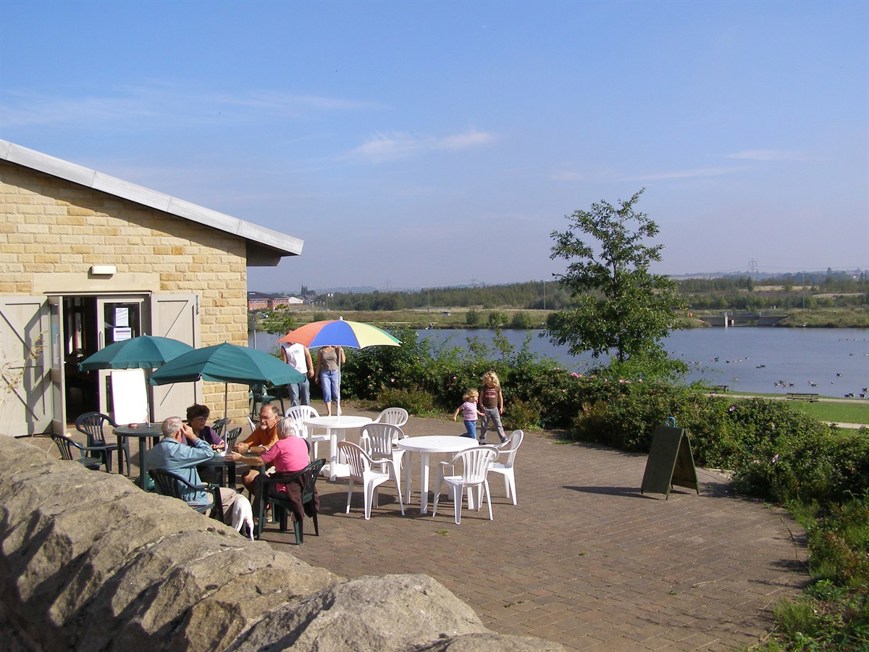
Poolsbrook has three lakes and ponds. The largest at just over 16 acres is Markham Lake, created by the deep mining subsidence on the site. The lakes and ponds are home to a wide range of aquatic wildlife including Cormorants, Mute Swans, Canada Geese, Pink Footed Geese and water voles. Fishing is also popular for tench, bream and carp.
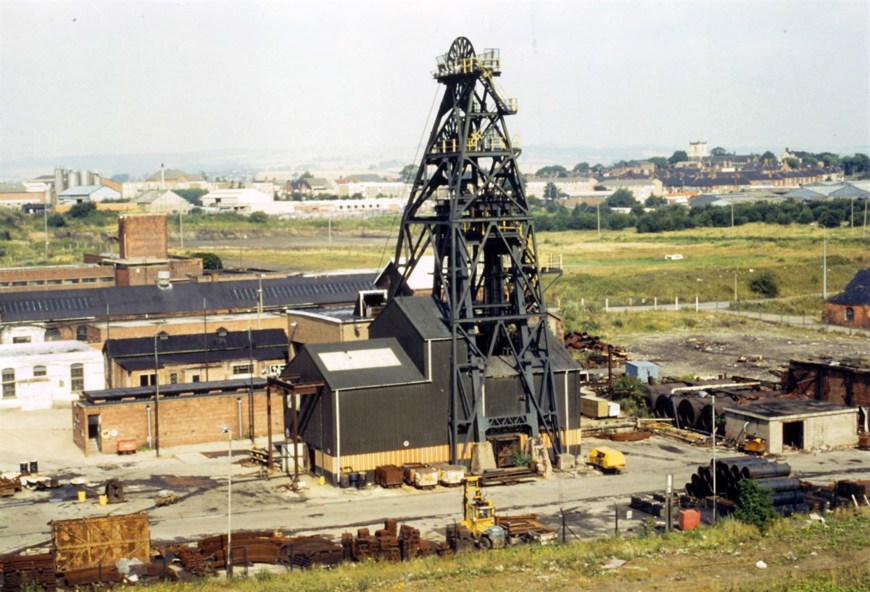
Ireland Colliery opened in 1874 and was part of the Staveley Coal and Iron Company. In 1986 it merged with Markham’s before finally closing in 1988. The Park’s mining heritage is marked at the entrance to the site by a pit head winding wheel from Markham Colliery.
Tapton Park
Tapton House and the surrounding park and gardens were presented to the Borough by Charles Paxton Markham in 1925. The house itself opened as Tapton House School in 1931 while the grounds and gardens were open to the public to enjoy. A large part of the 200 acre site was turned into a public golf course in 1934.
The Earth and Wildflower Labyrinth in the Park was part of the Borough Council’s Per Cent for Art Scheme after the building of Tapton Innovation Centre. Designed by landscape architect, Jim Buchanan, it opened in 1997 and is planted with a variety of wildflowers.
Greenhouses and areas to grow bedding plants were essential for Chesterfield’s Parks Department to maintain the planting in the parks. During the Second World war, land at Tapton was used by the County War Agricultural Committee for experimenting in the cultivation of outdoor grown tomatoes.
Tapton House is an 18th century building and was home to prominent people in Chesterfield’s history. It was home to George Stephenson from 1832 until his death in 1848. The House was then bought by Charles Markham. After it was given to the town in 1925, the House became Tapton House School. The School closed in 1994 and the building became part of Chesterfield College.
Opening in 1997, Tapton Park Innovation Centre was a partnership project with the Borough Council, North Derbyshire Chamber of Commerce and North Derbyshire Training and Enterprise Council, providing modern workspaces to encourage new businesses in the town.